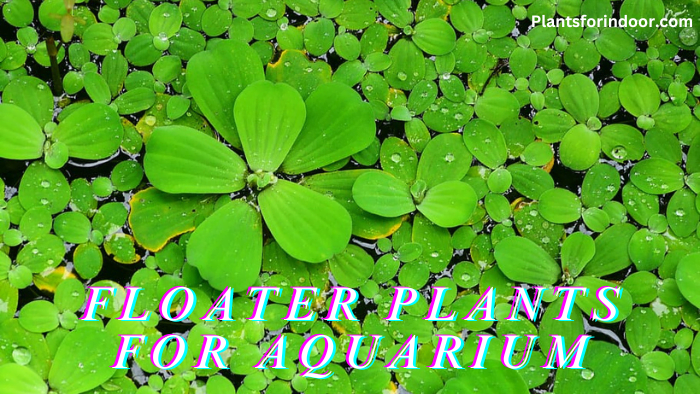If you’re looking to add a touch of beauty and liveliness to your underwater oasis, floater plants are your new best friends.
Floater plants are special aquatic plants that don’t need to be planted in the substrate; instead, they gracefully float on the water’s surface.
With their vibrant colors and delicate leaves, these plants provide shelter for your aquatic friends, help control algae growth, and create a soothing ambiance.
From the charming Water Lettuce to the classic Duckweed, floater plants are an easy and wonderful way to enhance the serenity of your aquarium.
Just let them drift, and watch your aquatic world come alive!
Pros of Floater Plants for Aquarium:
- Floater plants serve as a natural filter, helping to reduce harmful substances such as nitrates and carbon dioxide in the aquarium water.
- They provide shade for fish and other aquatic creatures, reducing stress and providing hiding spots.
- Some species of fish or shrimps enjoy eating floaters, so they can be a source of nutrition.
- Floaters enhance the aesthetic appeal of your aquarium with their vibrant green color and unique forms.
- The roots of floater plants offer an excellent breeding ground for beneficial bacteria.
Cons of Floater Plants for Aquarium:
- They can overcrowd the top layer of the tank, limiting light penetration for submerged plants that require plenty of light to grow.
- If not properly managed, floating plants can overgrow and make maintenance activities like feeding or cleaning more challenging.
- Certain types of floater plants may not be suitable for all kinds of fishes due to different pH level requirements or potential toxicity issues.
- They may harbor pests like snails or parasites which can lead to infestation in your tank if not carefully checked before introducing them into the aquarium.
- Floating plants often require specific water conditions (like temperature or nutrient levels) to thrive and maintaining these conditions might be difficult for some aquarists+.
Choosing the Right Floater Plants
Selecting suitable floater plants depends on various factors, including the size of your aquarium, the species of fish you keep, and the intensity of light your tank receives.
Some popular options include Duckweed, Water Lettuce, and Salvinia. Each type has unique characteristics that can influence the balance of your aquarium.
Caring for Floater Plants
Caring for floater plants is relatively straightforward. Most varieties thrive in moderate to high light conditions, but be cautious of too much direct light.
Regularly check water parameters and trim excess growth to prevent overcrowding.
Routine water changes will help maintain water quality and ensure your plants receive the nutrients they need.
Creating a Thriving Aquarium Ecosystem
The introduction of floater plants contributes to the creation of a thriving ecosystem within your aquarium. As these plants absorb nutrients, they compete with algae for resources, naturally minimizing algae growth. Additionally, the plant’s roots provide shelter for fry (young fish) and invertebrates, offering a natural nursery area.
Popular Floater Plant Varieties
Duckweed (Lemna minor)
Duckweed is one of the smallest and most common floating plants. Its tiny leaves create a delicate carpet on the water’s surface, providing shade and shelter.
Water Lettuce (Pistia stratiotes)
Water Lettuce is recognized by its rosette of velvety leaves resembling lettuce. It’s excellent for larger aquariums and adds a unique aesthetic.
Salvinia (Salvinia spp.)
Salvinia has distinctive leaves with hair-like structures that repel water. It forms clusters on the surface, aiding in shading and nutrient absorption.
Adding Floater Plants to Your Aquarium
Introducing floater plants is a simple process. Place them on the water’s surface, and they’ll naturally disperse.
Make sure not to overcrowd, allowing each plant enough space to thrive.
Maintenance and Troubleshooting
Regular maintenance involves removing excess growth, ensuring proper lighting, and monitoring water parameters.
If your floater plants start to decline, check for nutrient imbalances or consider adjusting lighting conditions.
Enhancing Aesthetics and Ambiance
Floater plants add a touch of elegance to your aquarium. Their varied shapes and sizes break the monotony of the water’s surface, creating a visually appealing and dynamic escape.
Promoting a Balanced Aquarium
As floater plants uptake nutrients, they assist in maintaining water quality. This balance contributes to a healthy environment, reducing stress on fish and promoting their well-being.
Preventing Excessive Growth
While floater plants are beneficial, they can grow rapidly under favorable conditions. Regularly thin out excess growth to prevent overcrowding and maintain a harmonious aquatic ecosystem.
Conclusion
Incorporating floating plants into your aquarium brings both aesthetic charm and functional benefits.
Their ability to enhance water quality, provide shelter, and contribute to a balanced ecosystem makes them an excellent addition to any aquatic setup.
By carefully selecting, placing, and maintaining floater plants, you can create a captivating underwater world that thrives with life and beauty.
FAQ’S
Will floating plants take up too much space?
Proper maintenance and trimming will prevent excessive growth, ensuring a balanced distribution.
Can floater plants coexist with other aquatic plants?
Yes, they can. However, ensure that other plants receive sufficient light by preventing excessive shading.
Will floating plants outcompete algae completely?
While they help control algae, complete elimination might not occur. Regular maintenance remains essential.
Can floater plants survive with goldfish?
Yes, but goldfish might nibble on the plants. Monitor their behavior and consider providing alternative food sources.
How often should I replace floating plants?
Replace as needed. Healthy plants can reproduce quickly, providing a steady supply.
I am a Horticulture graduate and passionate gardener with expertise in identifying, growing, and caring for plants, trees, and seeds. With a focus on sustainable practices, they aim to promote environmental awareness and appreciation for the natural world.








